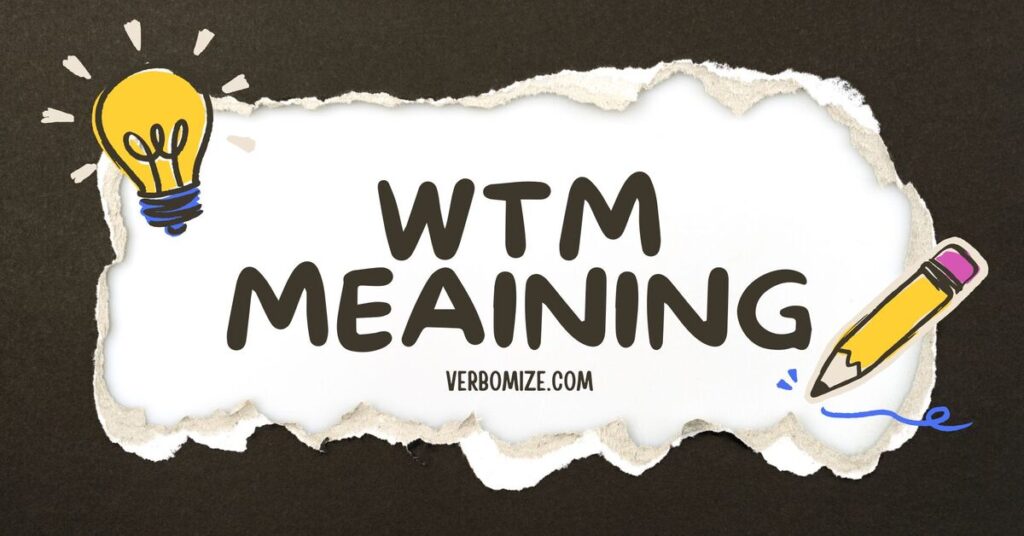If you’ve ever come across the acronym WTM and wondered what it actually means, you’re not alone. This popular slang term is buzzing all over social media and casual conversations, and knowing how to use it can make you sound like a pro in group chats or text exchanges. Whether you’re trying to ask about plans, check in with someone, or just express confusion, WTM has you covered.
In this article, we’ll break down the WTM word meaning, show you how it fits into everyday conversations, and give you plenty of examples to help you start using it like a seasoned texter. Keep reading—this is one acronym you don’t want to miss!
What Exactly Does WTM Stand For?
WTM can have different meanings depending on the context in which it is used. The most common interpretations include:
- What’s the Move?
This version of WTM is often used to ask someone about their plans or what they intend to do next. It’s a laid-back way of asking, “What’s the plan?” or “What’s going on?” It’s typically used among friends or in social settings to check on plans or make decisions together. - What’s the Matter?
In this case, WTM is used to express concern or inquire about someone’s well-being. It’s equivalent to asking, “What’s wrong?” or “Is everything okay?” It’s a more thoughtful or considerate way of using the acronym. - Whatever That Means
Here, WTM expresses confusion, sarcasm, or frustration. If someone says something unclear or confusing, the response “WTM” is an informal way of acknowledging that the phrase or statement doesn’t make sense or isn’t worth further explanation. It’s like saying, “Alright, I suppose,” or “I’m not fully understanding.”
These different meanings allow WTM to serve multiple functions in conversations, which is part of its charm and versatility in modern slang.
The Origins of WTM: How Did It Begin?
Like many slang terms and internet abbreviations, WTM emerged from casual digital communication, particularly on social media platforms and texting. As texting and instant messaging grew in popularity, people started seeking ways to simplify and speed up their conversations, which led to the creation of acronyms and abbreviations like WTM.
The most frequent use of WTM is “What’s the Move?” likely gained traction in the early 2010s, when informal slang and shorthand communication dominated platforms like Twitter, Snapchat, and Instagram. Over time, the phrase spread across group chats, gaming communities, and meme culture, embedding itself further into daily conversation.
The other meanings of WTM—“What’s the Matter?” and “Whatever That Means”—appeared as variations in response to different social cues and conversational needs. Their rise corresponds to how internet language evolves quickly to meet the needs of modern communication, especially when responding to ambiguity or planning spontaneous events.
How to Use WTM in Everyday Conversations
Now that you know the meanings behind WTM, let’s dive into how to use it effectively in conversations. Here are a few examples:
“What’s the Move?”
- Example 1:
“Hey, it’s getting late. WTM? Are we going out or staying in?”
In this case, WTM is used to ask about plans—whether they are going to hang out or call it a night. It’s a great conversation starter when you’re trying to make decisions about what to do. - Example 2:
“WTM tonight? Do you wanna hit the new café?”
Here, WTM is asking someone if they want to go out and grab a coffee. It’s a laid-back way of suggesting an activity.
“What’s the Matter?”
- Example 1:
“You seem quiet today, WTM? Are you okay?”
This usage is a more empathetic expression, used when someone might seem down or out of sorts. It’s a way of checking in to see if something is bothering them. - Example 2:
“WTM? You don’t seem yourself lately.”
This is another way to ask if something is troubling someone, showing concern in a non-intrusive way.
“Whatever That Means”
- Example 1:
“He said he was busy with ‘work’… WTM?”
In this case, “WTM” indicates the speaker’s confusion or doubt about the sincerity of the other person’s statement. It’s often used when the speaker doesn’t quite understand the logic or meaning behind someone’s words. - Example 2:
” She said she’s going to’ suppose about it.’ What is the move?” That sounds like a no.”
Here, the speaker sarcastically questions the meaning behind the vague statement, implying they don’t believe the other person’s words.
Who Typically Uses WTM?
WTM is a slang term that’s mostly used by younger people—teens and young adults—especially in social settings. It’s commonly found in group chats, private messages, and social media comments. The phrase is most popular among people who frequently use social platforms like:
- TikTok
- Snapchat
In these settings, WTM serves as an easy and informal way to communicate. It’s part of the broader internet slang culture, where people condense phrases into easy-to-understand acronyms for quicker exchanges.
If you are part of a group that frequently chats on these platforms, you’re likely to hear WTM used casually among friends, in memes, or even as part of playful banter. It’s a way to keep conversations flowing without needing to type out long phrases.
Real-World Examples: How WTM Shows Up in Sentences
Here are more detailed examples to show how WTM can fit into different contexts:
- Example 1:
“I just finished work. WTM? What’s our plan for the evening?”
This is asking about evening plans after a long day. - Example 2:
“I just saw your post! WTM? You look so different now!”
This could be used to ask for clarification on something unusual or surprising. - Example 3:
“You seemed upset earlier. WTM? Is something going on?”
This version expresses concern about someone’s emotional state. - Example 4:
“Ugh, she said something about going ‘out later’. WTM? What does that even mean?”
Here, WTM is used to show confusion or frustration with someone’s unclear statement.
Synonyms and Similar Expressions to WTM
Depending on the context in which WTM is used, several synonyms or alternative phrases can be employed. Some of these include:
- What’s the Plan?
A simple alternative for asking about upcoming activities or events. - What’s Up?
A more general expression used to ask what someone is doing or how they’re feeling. - What’s Going On?
A more open-ended question that can be used in both casual and slightly more serious conversations. - What’s the Deal?
This is another way to express confusion, similar to “Whatever That Means.” - What’s Wrong?
This is a synonym for “What’s the Matter?” when expressing concern about someone’s well-being.
The Opposite of WTM: Antonyms and When to Use Them
While WTM is often used to ask about plans or express concern, there are times when you might want to express the opposite sentiment. Here are a few examples of antonyms or phrases that convey the opposite of WTM:
- “All Set”
This implies everything is planned and ready, opposite of asking what’s coming next. - “Nothing Planned”
In contrast to WTM asking about future moves, this shows that there are no current plans in place. - “No Problem”
Instead of questioning or checking in on someone, this phrase reassures or dismisses concerns.
These antonyms are used when you’re either making a statement about no plans or dismissing any need for further questions.
Answering Your Top Questions About WTM
Here are some frequently asked questions to further clarify WTM and its uses:
- Q: Is WTM formal or informal?
A: WTM is highly informal and should only be used in casual conversations, typically with friends or peers. - Q: Can WTM be used in professional conversations?
A: It’s best to avoid using WTM in professional settings, as it may seem too casual or unprofessional. - Q: Does WTM have any regional variations?
A: While WTM is widely used across the internet, some regional variations of slang or shorthand might exist, depending on the online communities.
The Role of WTM in Digital Culture
WTM plays an important role in digital communication, especially in the age of rapid information exchange and social media influence. It’s an example of how language adapts to fit the fast-paced nature of online interactions. Social media platforms like TikTok and Instagram have helped popularize these abbreviations by encouraging a style of communication that’s quick and snappy.
WTM is also part of the broader trend of internet slang and abbreviations, where shortening phrases makes conversations more efficient, leaving room for more engagement and interaction without overwhelming users with long texts.
Fun Facts and Surprising Insights About WTM
- Popularity Surge During the Pandemic: During the COVID-19 lockdowns, social media and texting communication saw a massive increase. With more people relying on online interactions, abbreviations like WTM became even more popular as they fit the “quick check-in” mentality of digital communication.
- Influence of Memes: As with many popular acronyms, WTM’s widespread use can be partly credited to meme culture, where shorthand is a way to convey humor and sarcasm in just a few words.
Final Thoughts: When to Use WTM and How It’s Shaping Conversations
WTM has become a key part of how we communicate online. Whether you’re asking about plans, checking on someone’s well-being, or expressing confusion, this versatile acronym has found a permanent place in casual and digital conversations.
So next time you’re texting your friends or chatting in a group, feel free to drop a WTM to keep things light and informal. Just remember to use it appropriately—stick to casual settings and keep it fun!

Jone Smith is an experienced blogger and content creator behind Verbo Mize. With a passion for storytelling and insightful commentary, Jone brings a wealth of knowledge on diverse topics. His expertise in blogging, combined with a keen eye for detail, makes his work both informative and engaging, offering readers valuable perspectives on a wide range of subjects.







